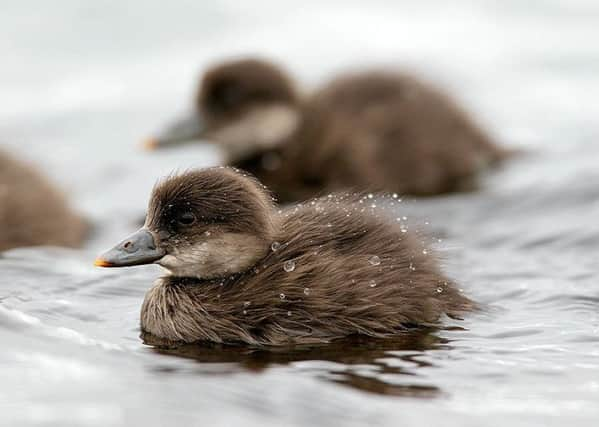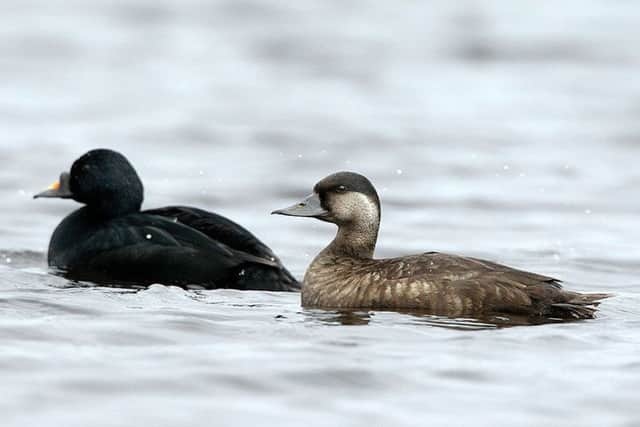'˜Floating islands' set to save rare duck at Highland lochs


The birds, which breed on the edges of a small number of lochs, will be helped by the creation of artificial floating islands made from redundant materials from fish farms.
It is hoped that the scoters will choose to nest on the islands and this will make the nests safer from the unwelcome attention of predators and the risk of being flooded.


Advertisement
Hide AdAdvertisement
Hide AdRSPB Scotland’s Dr Alison MacLennan said: “Within the last forty years the population of the now inappropriately named Common Scoter has fallen from several hundred pairs, with a wide distribution over the north and west of Scotland, to around fifty pairs found in a few isolated lochs.
“We are in real danger of losing this lovely bird as a breeding species in Scotland and I am delighted that this partnership has come together to help provide them with a future.”
Research conducted by a partnership of organisations including the Wildfowl and Wetlands Trust (WWT), Scottish and Southern Energy (SSE), Forestry Commission Scotland (FCS), Scottish Natural Heritage (SNH), Blue Energy, the Ness & Beauly Fisheries Trust and RSPB , has pointed to a number of causes for this decline, many of which are linked to changing uses in the landscape.
In addition, mammalian predators have been identified as having a significant detrimental effect on the survival of common scoter nesting attempts and their success in hatching ducklings.


In an attempt to address this problem in some of the Inverness-shire lochs, the partnership group joined forces with Fusion Marine and Marine Harvest to produce floating islands that will provide the ducks with safer nest locations with a reduced risk of predation.
Two of these islands have now been sited in common scoter breeding lochs in Inverness-shire as a trial to see if their use can boost the ducks’ success in rearing their young.
Arthur Campbell from Marine Harvest said, “We are delighted to support this project and particularly since the rafts have been constructed using materials recycled from some of our marine fish farms.
Advertisement
Hide AdAdvertisement
Hide Ad“The ducks may have come across the black pipes in their previous use as the walkways around fish farm cages at sea but we are hoping that they will take a second look at them now that they are disguised as heather clad islands.”
Alastair Stephen, a partner in the Inverness-shire project and SSE’s Freshwater Fisheries Biologist commented, “Generation of power from the large hydro reservoirs in our glens is an important part of our contribution to the national grid, but we don’t wish to see our wildlife adversely impacted in the process. The provision of floating islands as potential nest sites will, we hope, provide more secure nest sites in situations where the draw down of water for hydro generation can leave islands connected to the shoreline and therefore accessible to mammalian predators. In addition, the floating island vegetation should be less affected by spates and inundation that can damage the growth of vegetation essential for giving cover to the incubating ducks.”
Alison MacLennan of RSPB Scotland added, “Floating islands have been very successfully used to boost productivity of black-throated divers for many years, but since divers tend to nest close to the water’s edge, a small island was perfectly adequate. Common scoters have a very different approach to selecting their nest sites, requiring dense vegetation to provide a secluded site that they approach from the air. We were conscious that we would have to provide a larger area of nesting habitat for scoters than for divers. That would require a much larger island which would also have to be more robust to withstand the effects of wind, ice and the flexing of the water. We are delighted with the rafts constructed by Fusion Marine and can only hope that the common scoters share our enthusiasm!”
Ed Burrell from the Wildfowl and Wetlands Trust said, “It’s great that the scoters now have the option of the floating rafts. Each summer we see some scoters nest on islands in these lochs, only to be flooded out by rising water and lose their eggs. If it gives just one or two nests the chance to succeed that will make a difference to these endangered birds.”
Kenneth Knott, Forestry Commission Scotland Environment Manager in Lochaber added: “We have been lucky to have been able to combine unwanted materials from Marine Harvest with the expertise of Fusion Marine who have built these extremely versatile islands out of recycled polyethylene sheeting and flotation pipes using their specialist electro-fusion welding technology. The rafts have been covered with turf cleared from ground works nearby so that they now look to all intents and purposes like a natural island.”
